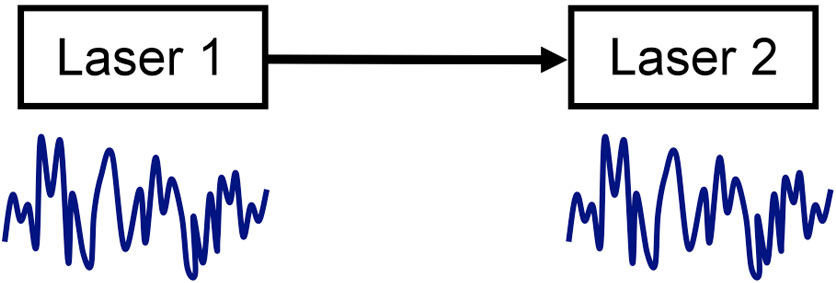Detailed presentation by themes
(2) Chaos synchronization
Among the research topics attracting deep interest in the field of chaos research, the phenomenon of chaos synchronization stands very high. Synchronization is defined as a state in which different nonlinear systems have the same oscillations. It is known that two ordinary pendula hanging on a same wall can oscillate at the same frequency and phase. Generally speaking, the technology of synchronization of periodic oscillators is used in many applications in the field of communication.
Systems likely to yield chaotic temporal evolutions showing synchronization are drawing very high interest. Chaos is a characteristic of systems in which, once a transient regime is overcome, the temporal evolutions of two close oscillations can exponentially diverge. This property relies on a high sensitivity to initial conditions. In consequence, even a small initial difference can result in chaotic evolutions showing totally different behaviours. Therefore, making chaotic systems show synchronization can be thought to be a counter-intuitive phenomenon and incompatible with the sensitivity to initial conditions particular to chaos.
However, it has been demonstrated that, under certain conditions, chaotic systems can show synchronization. Figure 1 presents the general principle of this idea. Although nonlinear systems generate irregular signals, when a first laser (laser 1) injects its output signal into a second (laser 2), the latter has the possibility to get his dynamics locked on the drive laser’s and hence to exhibit the same temporal evolution. The capability of undergoing chaos synchronization induced by an injected signal is essential in those systems.
 Figure 1: Chaos synchronization
Figure 1: Chaos synchronization
In the present case where the chaotic waveforms are identical, the phenomenon is termed total synchronization. In order to perform total synchronization, the two coupled nonlinear systems in play must have approximately the same physical structure and parameters values. The stability of the synchronized state depends on these parameters and, in laser systems, various parameter conditions suitable for synchronization exist.
Since chaos synchronization is a counter-intuitive physical phenomenon, it draws interest from many researchers who dedicate intense academic research to it. Moreover, since the suitability of chaos synchronization for secure data transmission was demonstrated, advances in engineering applications have been actively expected. In particular, many studies aiming at applying chaos synchronization in lasers with unidirectional coupling are being reported in the fields of secure optical communications and secret key distribution.
